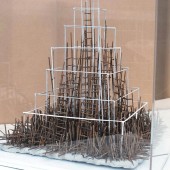Walid Siti
- Country: Iraqi Kurdistan
- Exhibitions:
- Alienation
- Between Two Rounds of Fire, the Exile of the Sea
The symbolic role of natural landscapes and constructed landmarks to collective memory is central to the work of esteemed Iraqi artist Walid Siti. Referencing the ancient citadel of Erbil with rudimentary symbols of Kurdish folklore such as mountains and rivers, Siti explores the relationship between the ancient and contemporary, the innate and the living, the eternal and the changeable. Using painting, drawing, printmaking and installation, Siti investigates aspects of collective memory with the individual experience amid changing socio-political realities.
Born in Dohuk in Iraqi Kurdistan in 1954, Siti lived in the former Yugoslavia before seeking political asylum in London during increasing aggression against those opposed to Iraq’s Ba’athist regime. Based in London since then, Siti’s experience of exile feeds into his analytical observations of the rapid changes in Erbil after its stagnation from years of war. Siti’s basic approach references the building blocks of societies; beginning each piece with a broad base mounting to form a peak, the artist repetitively layers brush strokes and shapes to reflect disparities between the lower and upper levels society. In Chasing Utopia, Siti examines parallels between two cities, Dubai and Erbil, where rapid transformation threatens cultural identity and natural surroundings.
Siti, who has exhibited internationally, participated in Iraq’s pavilion at the 54th Venice Biennale.
